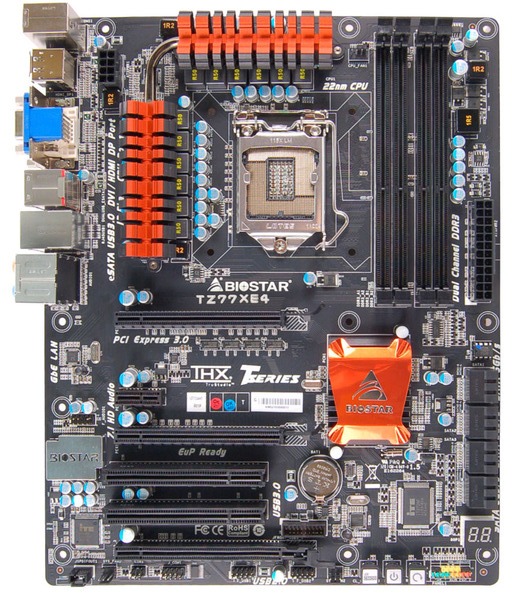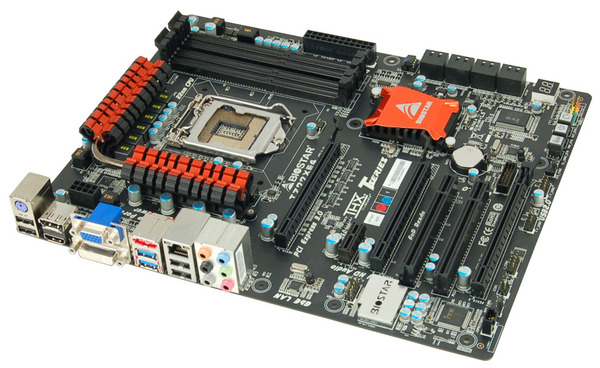Intel Z77 Panther Point Chipset and Motherboard Preview – ASRock, ASUS, Gigabyte, MSI, ECS and Biostar
by Ian Cutress on April 8, 2012 12:00 AM EST- Posted in
- Motherboards
- Intel
- Biostar
- MSI
- Gigabyte
- ASRock
- Asus
- Ivy Bridge
- ECS
- Z77
Biostar TZ77XE4—Visual Inspection
With memories of Biostar fresh in my mind from the 990FX roundup, I have another chance to tackle a motherboard from them. This one comes in at more of a premium than the other—at an MSRP of $169 it is not the cheapest board this time. However, it does seem to have learned some lessons with the PCIe layout at least, but in terms of features we are perhaps a bit lacking.
Biostar have characteristically been black and orange, and we see it here again on their top Z77 model, the TZ77XE4. Power delivery is essentially a 10+2 (CPU/iGPU) system with large brightly colored heatsinks to remove heat, both connected via a heatpipe. These heatsinks are set a little away from the Intel designated socket area, though the memory banks are right up against the boundary—with only two sticks of memory in the board there will be enough room for most of the beefiest air coolers.
In terms of fan headers, Biostar have unfortunately put much effort in here, with only three to play with—a 4-pin CPU fan header to the top right of the socket, and two 3-pin at the south end of the board. Anyone requiring headers for fans will have to resort to providing their own fan control.

Along the right hand side, apart from the 24-pin power connector, we have a series of eight SATA ports—two SATA 6 Gbps from the PCH, four SATA 3 Gbps also from the PCH, and another two SATA 6 Gbps from an ASMedia controller. These are unfortunately not color coded, meaning users will have to double check every time that the SATA cable is going into the port as intended. Below these, we have a two-digit debug display for error reporting.
The chipset heatsink sports the bright orange Biostar color, but is rather small which could lead to it being warm to the touch. On the south side of the board, we are not exactly bursting with headers—aside from the fans, we have front panel headers, a pair of USB 2.0 headers, and power/reset/clear CMOS buttons. These buttons are all similar and next to each other, so I can just see myself accidentally pressing the wrong one from time to time. It is also important to note the location of a USB 3.0 header, just above the third full-length PCIe slot. This is a rather awkward place, and cements its use primarily for rear facing adaptors (as long as there is nothing in the PCI slot beside it).

The PCIe layout is better than previous iterations, featuring an x16 (x8 in dual-GPU), x1, x8, PCI, PCI and Gen 2.0 x4. This leaves a space between GPUs, and a spare x1, PCI and x4 when dual GPUs are being used. Note we do not have a molex connector here, suggesting that Biostar are happy with the power delivery when the PCIe slots are in use.

For back panel functionality, we have a PS2 keyboard port, two USB 2.0 ports (black), DisplayPort, HDMI, D-Sub, DVI-I, eSATA, two USB 3.0 (blue), gigabit Ethernet, two more USB 2.0 (black), and audio jacks. I should stress that even though there is a DVI-I on the back panel, it does not accept analog signals by adaptor.
Board Features
| Biostar TZ77XE4 | |
| Size | ATX |
| CPU Interface | LGA-1155 |
| Chipset | Intel Z77 |
| Power Delivery | 10 + 2 + 1 + 2 (CPU/GPU/VCCIO/Memory) |
| Memory Slots |
Four DDR3 DIMM slots supporting up to 32 GB Up to Dual Channel, 1066-2600 MHz |
| Video Outputs | DisplayPort, HDMI, DVI-D, D-Sub |
| Onboard LAN | Realtek 8111E |
| Onboard Audio | Realtek ALC898 |
| Expansion Slots |
2 x PCIe x16 Gen3 (x16, x8/8) 1 x PCIe x16 Gen2 (x4) 1 x PCIe x1 Gen2 2 x PCI |
| Onboard SATA/RAID |
2 x SATA 6 Gbps (PCH), Support for RAID 0, 1, 5, 10 4 x SATA 3 Gbps (PCH), Support for RAID 0, 1, 5, 10 2 x SATA 6 Gbps (ASMedia Controller) 1 x eSATA 3 Gbps |
| USB |
4 USB 3.0 ports (2 back panel, 2 from headers) 8 USB 2.0 ports (4 back panel, 4 from headers) |
| Onboard |
4 x SATA 6 Gbps 4 x SATA 3 Gbps 1 x USB 3.0 Header 2 x USB 2.0 Header 3 x Fan Headers 1 x CIR Header 1 x SPDIF Output Header 1 x Front Panel Audio Header |
| Power Connectors |
1 x 24-pin ATX connector 1 x 8-pin 12V connector |
| Fan Headers |
1 x CPU Fan Header (4-pin) 2 x SYS Fan Header (3-pin) |
| IO Panel |
1 x PS/2 Keyboard Port 1 x eSATA 2 x USB 3.0 4 x USB 2.0 1 x DisplayPort 1 x HDMI 1 x DVI-D 1 x D-Sub 1 x Gigabit Ethernet Audio Jacks |
| Warranty Period | 3 years from date of sale |
| Product Page | Link |
Aside from the extra SATA controller, PCI slots, Power/Reset buttons and the use of all four display outputs, there's nothing much 'extra' that Biostar have put on the board which isn't already in the default chipset. This could perhaps be their downfall when it comes to conclusions after testing.










145 Comments
View All Comments
extide - Tuesday, April 10, 2012 - link
Do you even know what it means to preempt a frame? Cavalcade is describing the technology correctly. He is explaining pretty much the same thing as you are but you just don't get it..Also separate input and rendering modules means a lot. Typically a game engine will have a big loop that will check input, draw the frame, and restart (amongst other things of course) but to split that into two independent loops is what he is talking about.
Iketh - Wednesday, April 11, 2012 - link
You really should look up "preemption." This is not what is happening... CLOSE, but not quite. Preemption is not the right word at all. This makes him incorrect and I kindly tried explaining. You are incorrect in backing him up and then accusing me of being inept. Guess what that makes you?On top of that, he's also not talking about splitting input and rendering into two loops. Not even close. How did you come up with this idea? He's asking how the input polling is affected with this technology. It is not, and can not, unless polling is strictly tied to framerate.
I want to be clear that I'm not for this technology. I think it won't offer any tangible benefits, especially if you're already over 100 fps, and they want to power up a second GPU in the process... I'm just trying to help explain how it's supposed to work.
Iketh - Sunday, April 8, 2012 - link
"handling input in a game engine" means nothing here. What matters is when your input is reflected in a rendered image and displayed on your monitor. That involves the entire package. Lucid basically prevents GPUs from rendering an image that won't get displayed in its entirety, allowing the GPU to begin work on the next image, effectively narrowing the gap from your input to the screen.Iketh - Sunday, April 8, 2012 - link
mistake post, sorryRyan Smith - Sunday, April 8, 2012 - link
The bug comment is in regards to HyperFormance. Virtual V-Sync is rather simple (it's just more buffers) and should not introduce rendering errors.Ryan Smith - Sunday, April 8, 2012 - link
Virtual V-Sync is totally a glorified triple buffering, however this is a good thing.http://images.anandtech.com/reviews/video/triplebu...
Triple buffering as we know it - with 2 back buffers and the ability to disregard a buffer if it's too old - doesn't exist in most DirectX games and can't be forced by the video card. Triple buffering as implemented for most DirectX games is a 3 buffer queue, which means every frame drawn is shown, and the 3rd buffer adds another frame of input lag.
On paper (note: I have yet to test this), Virtual V-Sync should behave exactly like triple buffering. The iGPU back buffer allows Lucid to accept a newer frame regardless of whether the existing frame has been used or not, as opposed to operating as a queue. This has the same outcome as triple buffering, primarily that the GPU never goes idle due to full buffers and there isn't an additional frame of input lag.
The overhead of course remains to be seen. Lucid seems confident, but this is what benchmarking is for. But should it work, I'd be more than happy to see the return of traditional triple buffering.
HyperFormance is another matter of course. Frame rendering time prediction is very hard. The potential for reduced input lag is clear, but this is something that we need to test.
DanNeely - Monday, April 9, 2012 - link
Lucid was very confident in their Hydra solution; but it never performed even close to SLI/xFire; and after much initial hype being echoed by the tech press it just disappeared. I'll believe they have something working well when I see it; but not before.JNo - Monday, April 9, 2012 - link
Thisvailr - Sunday, April 8, 2012 - link
Page 8 quote: "The VRM power delivery weighs in at 6 + 4 phase, which is by no means substantial (remember the ASRock Z77 Extreme4 was 8 + 4 and less expensive)."Yet: the "Conclusions" chart (page 14) shows the same board having 10 + 4 power.
Which is correct?
flensr - Sunday, April 8, 2012 - link
I'm bummed that ASUS didn't include mSATA connectors. Small mSATA SSDs would make for great cache or boot drives with no installation hassles and they're pretty cheap and available at the low capacities you'd want for a cache drive. That's a feature I will be looking for with my next mobo purchase.Ditching USB 2.0 is also one of the next steps I'll be looking for. Not having to spend a second thinking about which port to plug something in to will be nice once USB 2.0 is finally laid to rest. Having only 4 USB 3.0 ports is stupidly low this long after the release of the standard, and it's hampering the development of USB 3.0 devices.
Finally, I've been repeatedly impressed by my Intel NICs over the last decade. They simply perform faster and more reliably than the other chips. I look for an Intel NIC when I shop for mobos.